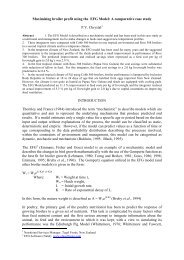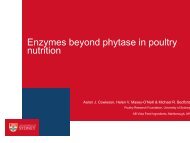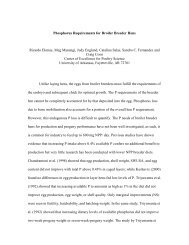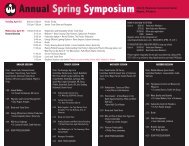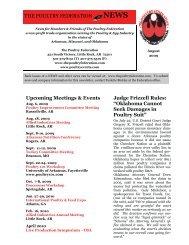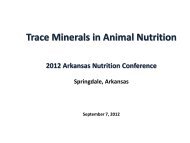New Feed Enzyme Development - The Poultry Federation
New Feed Enzyme Development - The Poultry Federation
New Feed Enzyme Development - The Poultry Federation
- No tags were found...
You also want an ePaper? Increase the reach of your titles
YUMPU automatically turns print PDFs into web optimized ePapers that Google loves.
September 2009, ChemGen Corp.Table 6 – β‐1,3‐glucan content of DDGS and yeast feed products% DDGS DDGS Brewers BDG BDG BDG MDGTotalmannoseAvg. 15samplesUSAmidwestDryYeast0.97 0.843 6.17China-1 China-2 Philippines ChinaSolublemannoseTotalglucoseSolubleglucoseβ‐1,3‐Glucan0.561 0.322 2.0095.918 7.873 6.1792.512 4.62 1.3340.298 0.525 3.814 1.02 0.79 0.5 1.012Testing β‐1,3‐glucanase in <strong>Feed</strong>ing Experiments<strong>The</strong> enzyme β‐1,3‐glucanase actually already exists in Hemicell®, but at a low level. <strong>The</strong> β‐1,3‐glucanaseexpression level in the Hemicell production strain was increased to a commercially useful level toprovide a safe supply from a host that does not contain any foreign DNA sequences. This feed‐approvedmicrobial strain also naturally produces a number of other potentially useful enzymes for feed that weplan to exploit. <strong>The</strong> new strain produces β‐mannanase and the β‐1,3‐glucanase simultaneously. <strong>The</strong>target dose for the β‐1,3‐glucanase like Hemicell® mannanase has been 70 to 100 MU/ton (ChemGenUnits).<strong>The</strong> new enzyme will be sold in combination with mannanase, but in some trials it was tested separatelyin a more purified form. Initially a 21 day cage trial was performed at Southern <strong>Poultry</strong> Research asdescribed in Table 7. <strong>The</strong> WAFC was significantly improved in the short 21 day test, and AGP wassignificantly reduced over control. This early result indicated that further testing and development of β‐1,3‐glucanse as a feed enzyme was warranted.In the first pen trial shown below was a 42 day turkey hen experiment comparing β‐1,3‐glucanse to acontrol, and Hemicell® and β‐1,3‐glucanse plus Hemicell®. This trial used a commercial type corn‐soydiet and feed was produced at a commercial mill. <strong>The</strong> results in Table 8 showed that this form of β‐1,3‐glucanase significantly reduced the AGP (again looking at AGP in a sub population of 30 birds only) butadding the combination of mannanase and glucanase did not reduce AGP further. <strong>The</strong> β‐1,3‐glucanasealso significantly improved the feed conversion over the control. Unlike the AGP result, the growthperformance was significantly better when the enzymes were combined. <strong>The</strong> Hemicell® and β-1,3-glucanase + Hemicell ® data is the average of two separate treatments in each case for a very highdegree of replication.D.M. Anderson and H. Hsiao, <strong>New</strong> <strong>Feed</strong> <strong>Enzyme</strong>s Page 21




